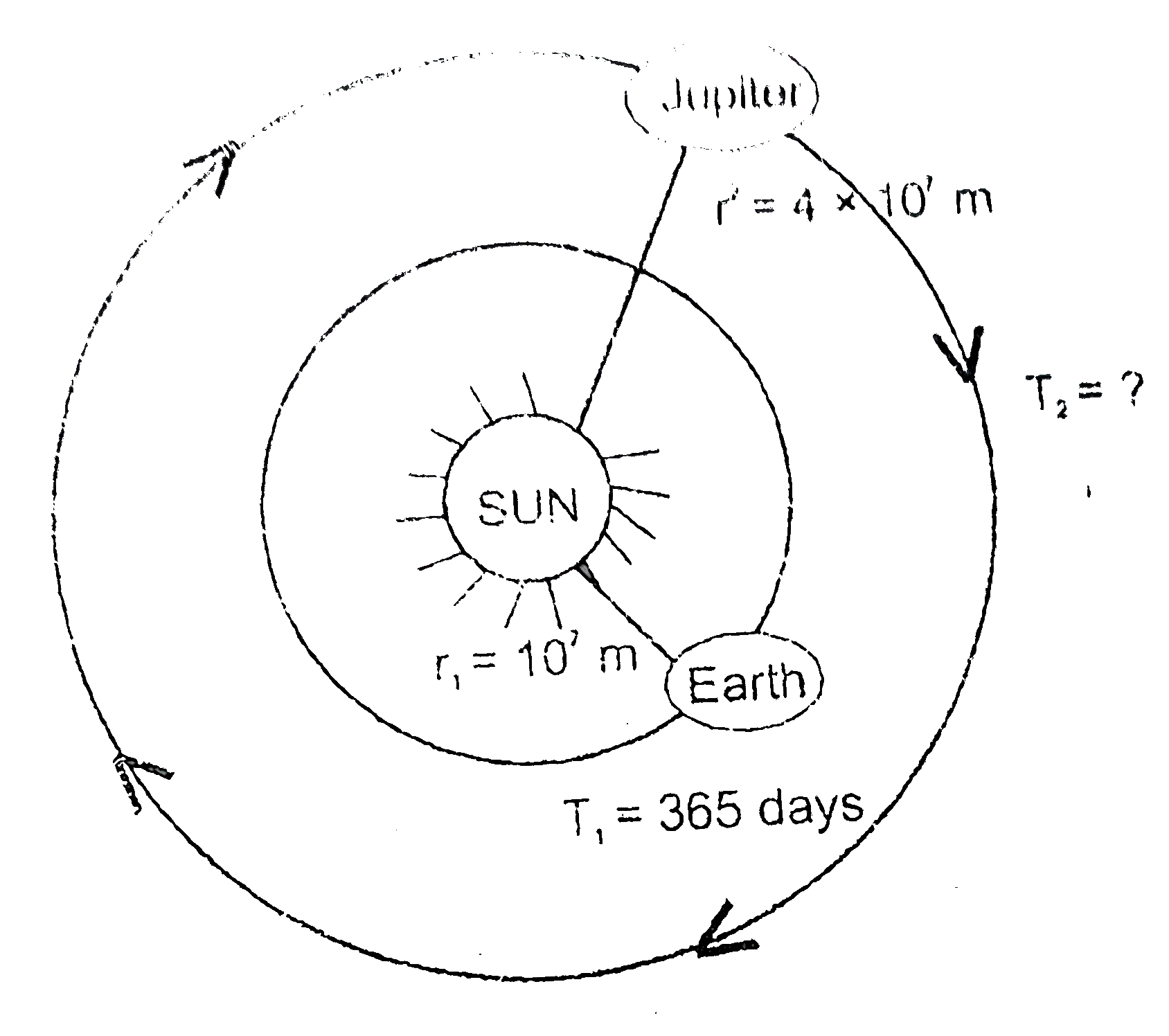Given that T2=kR3, express the constant k of the above relation in days and kilometres. Given, k=10−13s2m3. The Moon is at a distance of 3.84×105km from the earth. Obtain its time period of revolution in days.
To solve the problem step by step, we will break it down into two parts:
Part 1: Expressing the constant k in days and kilometers.
1. Given Information:
- The constant k=10−13s2m−3.
- We need to convert this to d2km−3.
2. Conversion Factors:
- 1 day = 24 hours = 24×60 minutes = 24×60×60 seconds.
- 1 kilometer = 103 meters.
3. Convert seconds to days:
- The number of seconds in one day is:
1day=24×60×60=86400s
- Therefore, 1s=186400days.
4. Convert meters to kilometers:
- Since 1km=103m, we have:
1m=10−3km
5. Substituting the conversions into k:
- We need to express k as:
k=10−13s2m−3=10−13(186400)2(10−3)−3
- Simplifying this:
k=10−13×1864002×109
6. Calculating k:
- First, calculate 864002:
864002=7.46496×109
- Now substituting this back:
k=10−13×1097.46496×109=10−47.46496≈1.34×10−14d2km−3
Part 2: Finding the time period of revolution of the Moon.
1. Given Information:
- Distance of the Moon from the Earth, R=3.84×105km.
- We already found k≈1.34×10−14d2km−3.
2. Using the formula T2=kR3:
- Substitute the values of k and R:
T2=1.34×10−14×(3.84×105)3
3. Calculating R3:
- First calculate (3.84×105)3:
(3.84)3≈56.65and(105)3=1015
R3≈56.65×1015
4. Substituting back to find T2:
- Now substitute back into the equation:
T2=1.34×10−14×56.65×1015
T2≈7.58×101(after calculating)
5. Finding T:
- Taking the square root:
T≈√7.58×101≈8.69days
Final Answer:
The time period of revolution of the Moon is approximately 27.3 days.
- The constant k=10−13s2m−3.
- We need to convert this to d2km−3.
- 1 day = 24 hours = 24×60 minutes = 24×60×60 seconds.
- 1 kilometer = 103 meters.
- The number of seconds in one day is:
1day=24×60×60=86400s
- Therefore, 1s=186400days.
- Since 1km=103m, we have:
1m=10−3km
- We need to express k as:
k=10−13s2m−3=10−13(186400)2(10−3)−3
- Simplifying this:
k=10−13×1864002×109
- First, calculate 864002:
864002=7.46496×109
- Now substituting this back:
k=10−13×1097.46496×109=10−47.46496≈1.34×10−14d2km−3
- Distance of the Moon from the Earth, R=3.84×105km.
- We already found k≈1.34×10−14d2km−3.
- Substitute the values of k and R:
T2=1.34×10−14×(3.84×105)3
- First calculate (3.84×105)3:
(3.84)3≈56.65and(105)3=1015
R3≈56.65×1015
- Now substitute back into the equation:
T2=1.34×10−14×56.65×1015
T2≈7.58×101(after calculating)
- Taking the square root:
T≈√7.58×101≈8.69days
The time period of revolution of the Moon is approximately 27.3 days.
Topper's Solved these Questions
- GRAVITATIONBOOK - CENGAGE PHYSICS ENGLISHCHAPTER - GRAVITATIONEXERCISE - Exercise 6.2
15 Videos
- GRAVITATIONBOOK - CENGAGE PHYSICS ENGLISHCHAPTER - GRAVITATIONEXERCISE - Exercise 6.3
16 Videos
- GRAVITATIONBOOK - CENGAGE PHYSICS ENGLISHCHAPTER - GRAVITATIONEXERCISE - INTEGER_TYPE
1 Videos
- FLUID MECHANICSBOOK - CENGAGE PHYSICS ENGLISHCHAPTER - FLUID MECHANICSEXERCISE - INTEGER_TYPE
1 Videos
- KINEMATICS-1BOOK - CENGAGE PHYSICS ENGLISHCHAPTER - KINEMATICS-1EXERCISE - Integer
9 Videos
Similar Questions
Knowledge Check
Rate constant of two reactions are given below. Identifying their order of reaction
k=5.3×10−2Lmol−1s−1
k=3.8×10−4s−1A(i) second order, (ii) first orderB(i) first order, second orderC(i) zero order, (ii) first orderD(i) second order, (ii) zero orderThe velocity constant of a reaction at 290 K was found to be 3.2×10−3s−1. When the temperature is raised to 310 K, it will be about
A6.4×10−3B3.2×10−4C9.6×10−3D1.28×10−2The velocity constant of a reaction at 290 K was found to be 3.2×10−3s−1. When the temperature is raised to 310 K, it will be about
A6.4×10−3B3.2×10−4C9.6×10−3D1.28×10−2
The rate constant for a second order reaction is given by k=(5×1011)e−29000k/T. The value of Ea will be:
View SolutionCalculate the area covered per second (m2s−1) by the Moon for one complete revolution round the Earth (distance of Moon from Earth =3.845×108 and period of revolution of Moon =2713 days).
View SolutionCalculate the distance from the earth to the point where the gravitational field due to the earth and the moon cancel out. Given that the earth-moon distance is 3.8×108m and the mass of earth is 81 times that of moon.
View SolutionThe Earth and Jupiter are two planets of the sun. The orbital radius of the earth is 107m and that of Jupiter is 4×107m If the time period of revolution of earth is T=365 days find time period of revolution of the Jupiter
 .
.
View SolutionThe velocity constant of a reaction at 290 K was found to be 3.2×10−3s−1. When the temperature is raised to 310 K, it will be about
View Solution
